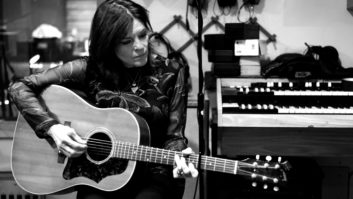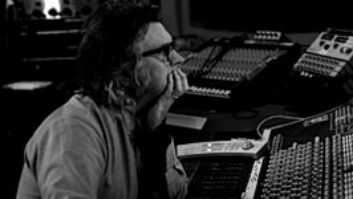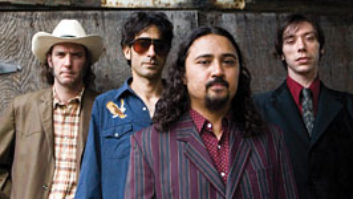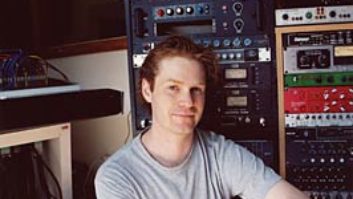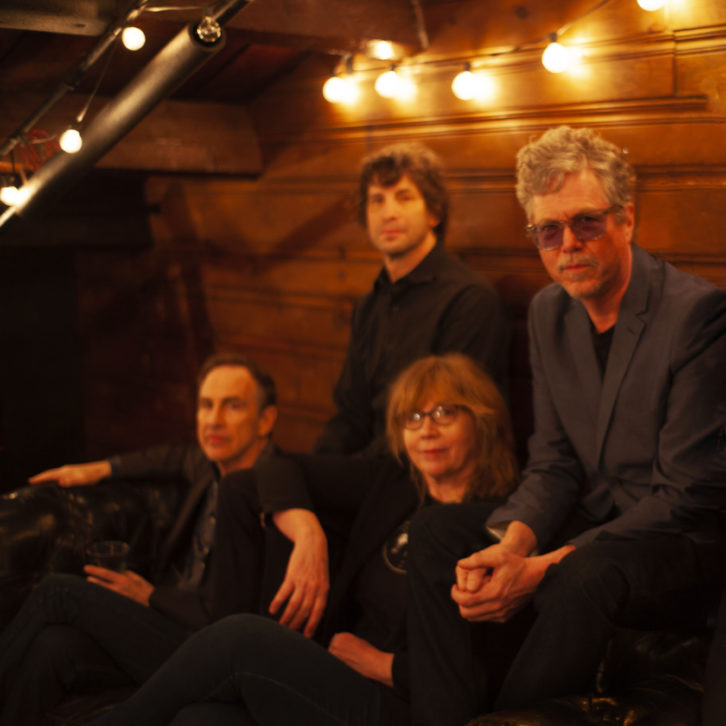
XOXO, the new album by The Jayhawks, sees members of this 35-year country-rock group collaborating more creatively than ever: trading vocals, harmonizing beautifully and building sounds from a deep well of roots music.
On “Forgotten Town,” frontman Gary Louris shares vocal duties with drummer/multi-instrumentalist Tim O’Reagan, while guitar parts weave between rock and twang, and Karen Grotberg’s piano rolls fluidly along. On the beautiful ballad “Ruby,” Grotberg plays and sings lead while Louris and O’Reagan harmonize in the background.
“During a typical Jayhawks concert, I sing about 95 percent of the lead vocals, and, to be honest, I get a little tired hearing myself whine about all my problems,” Louris says. “I love Karen and Tim’s voices. I know the audience also wants to hear them sing more.”
Tracking at Pachyderm
The band started building these songs with basic tracking at stalwart Minneapolis studio Pachyderm, where engineer Nick Tveitbakk set up stations that allowed the band members to record live.
“We have a lot of isolation,” Tveitbakk explains. “Karen was in a room with a grand piano. Gary was in a room with acoustic and sometimes electric [guitar], sometimes vocals at the same time. [O’Reagan and bassist/multi-instrumentalist Marc Perlman] were in the main room together facing each other; everybody had sight lines.”
Tveitbakk tracked to his Studer A827 2-inch tape machine and Pro Tools HDX. “Because we have a very large and very nice [48-channel] API console, we can track to tape and run it into Pro Tools simultaneously,” he says.
On O’Reagan’s drums, Tveitbakk kept things simple. “I don’t like to do a ton of drum tracks, so I’m busing kick and snares together. I use Beyer m88s on those. Overheads are a pair of [AKG] C12s, and I had a C24 for the room. The Pachyderm live room is one of my favorites for drums.”
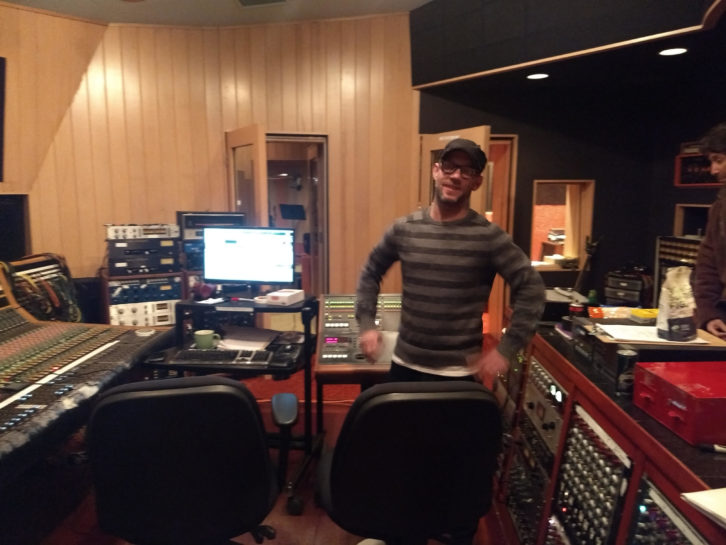
Perlman’s bass went through an Ampeg B15 for harder-edged Americana songs and through an Ampeg SVT amp for softer tunes. “That was compressed with an LA2A. All the drums and bass went through Neve mic pres,” he explains. “We have 1064, 1081 1073, 1084—a large variety of those.”
Acoustic guitars were miked with an AKG C414EB and a Coles 4038 side by side, and vocals went into Neumann U47 and Shure SM7 mics, also side by side, to provide a range of textures. “We’re always going for keeper vocals, so the option is there,” Tveitbakk says.
Grotberg played the studio’s Yamaha GH1 piano. “It’s not as bright like a C7 and has some very nice hardware on it,” says Tveitbakk. He put up a pair of Neumann KM54s through 1081 mic pres into a stereo Tube-Tech compressor.
On to Flowers Studio
“Then, when we shifted to overdub mode we wanted to work at Flowers Studio in Minneapolis,” Louris says. “We had hoped to work with our friend and owner of Flowers, Ed Ackerson, but sadly he passed away before we could start.”
Flowers Studio is now owned by Ed Ackerson’s wife, and it is run by engineer Kris “KJ” Johnson.
“We were also friends of KJ from dealing with him at Twin Town Guitars [where he builds and repairs amps],” Louris says. “He stepped in and we all immediately fell in love with his easy demeanor. He is so talented and was patient with us, as there were more moving parts than usual because of the multiple songwriters. Each person who brought in the song took ownership of the production.”
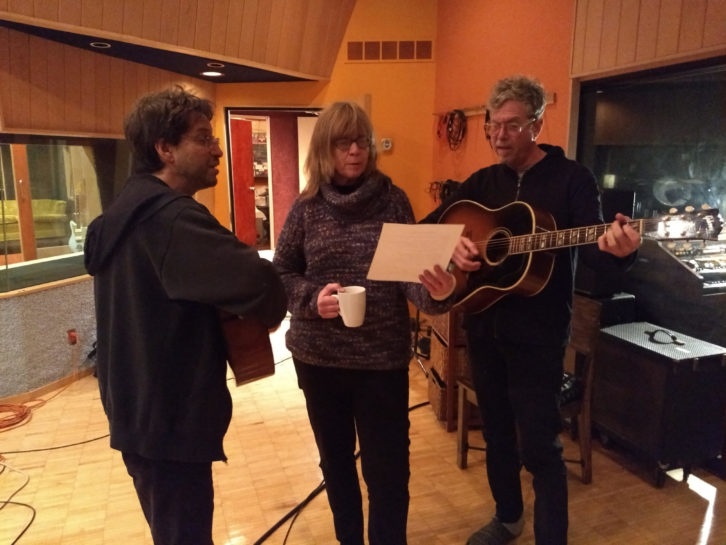
For the Jayhawks sessions, KJ took a similar approach to Tveitbakk’s by setting up isolated instrument and vocal stations that allowed for sight lines.
“We cut 90 percent of the lead vocals through a Wunder CM7 mic, which I really love,” KJ says. “That went through a Neve 1066 preamp, and then a Revision H 1176. Also, in the big room we had a Neumann M149 tube mic, which we used for group vocals. Sometimes all three of them would be singing around one mic.”
On some tracks, Louris played what KJ says is “the most heaviest Telecaster; it’s like a boat, but it sounds great and Gary loves it. He used that most often through a ’65 reissue Twin Reverb from the late ’90s. We also had an early Vox AC30 and a really cool Selmer Zodiac Twin. He also did some fun stuff where we put a Super Reverb in the large room and played some loud feedback with every knob on 10.
“Each amp had its own recording chain,” KJ continues. “The AC30 might go to a Black AKG 414EB. We have an SSL AWS 900, which I used as a channel for that, and on the Twin we used a Sennheiser 409, and that would have gone through either a Neve 3104 channel or one of the Calrec 1061s that we have—they’re laser-beam focused.”
Bass—often the studio’s mid-’60s rosewood P-Bass—was direct into a Neve 3104 channel then through a dbx 165 into Pro Tools. Many of the studio’s keyboards were also used, including a Wurlitzer organ and Hammond M with a Leslie 222 and a Mellotron 4000 D, as well as a Yamaha grand piano.
Creating a Seamless Mix
XOXO was mixed by Paul Q. Kolderie in his personal studio in upstate New York. “I grew up in Minnesota but didn’t meet Gary until he came to Boston to play on an Uncle Tupelo record I was producing in 1991,” recalls Kolderie, who mixes on his Pro Tools HD24 rig and monitors mostly on Genelec 1030As.
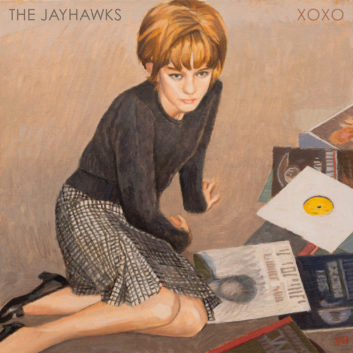 “I mix everything through analog equipment, though,” he interjects. “I do the automation stuff in Pro Tools and then run through gear like [Universal Audio] LA3As and the incomparable Pandora LM-402 limiter. The centerpiece is an unusual, all-discrete Neve console that was custom-made in the ’70s for a TV station. I bought it on eBay and it was a mess, but I had a great tech who turned it into a monster. It’s got a lot of horsepower! After the board, the mix runs through a Smart C2 stereo compressor to an Ampex ATR-102 half-inch tape deck, which is probably the most important thing of all.”
“I mix everything through analog equipment, though,” he interjects. “I do the automation stuff in Pro Tools and then run through gear like [Universal Audio] LA3As and the incomparable Pandora LM-402 limiter. The centerpiece is an unusual, all-discrete Neve console that was custom-made in the ’70s for a TV station. I bought it on eBay and it was a mess, but I had a great tech who turned it into a monster. It’s got a lot of horsepower! After the board, the mix runs through a Smart C2 stereo compressor to an Ampex ATR-102 half-inch tape deck, which is probably the most important thing of all.”
Kolderie says his biggest challenge was to ensure a seamless sound. “Each person’s material had a different vibe,” he observes. “We had to knit it all together cohesively. It wasn’t hard, but it took time to sort it out. What I loved from the beginning was, they really trust each other.”
In the end, XOXO expresses the joy that these band members have playing together, while the songwriting runs deep. The song “Living in a Bubble,” for example, resonates on multiple levels.
“‘Living in a Bubble’ was written and recorded pre-pandemic and was more about the ill effects of social media, the 24-hour news cycle, and our connection to devices than about any worldwide crisis,” Louris explains. “It is about the good and the bad effects of isolation. Who knew what was coming down the pike? I know that there have been times that what I have written has turned out to be prophetic…this is certainly one of those times.”

